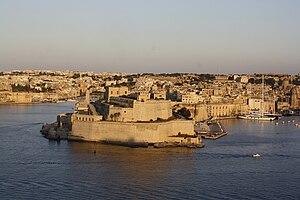Battle of Malta
| Battle of Malta | |||||||
|---|---|---|---|---|---|---|---|
| Part of War of the Sicilian Vespers | |||||||
 The Castello del Mare (modern day Fort Saint Angelo), seen from Valletta. The castle underwent many renovations and re-modellings since the 13th century. |
|||||||
|
|||||||
| Belligerents | |||||||
|
|
|
||||||
| Commanders and leaders | |||||||
| Roger of Lauria | Guillaume Cornut † Bartholomé Bonvin |
||||||
| Strength | |||||||
| 18–21 galleys 5,500 men |
19–22 galleys 7,800 men |
||||||
| Casualties and losses | |||||||
| 300 men dead 200 men injured |
3,500 men dead 860 men prisoners 10 galleys captured |
||||||
The Battle of Malta took place on 8 July 1283 in the entrance to the Grand Harbour, the principal harbour of Malta, as part of the War of the Sicilian Vespers. An Aragonese fleet of galleys, commanded by Roger of Lauria, attacked and defeated a fleet of Angevin galleys commanded by Guillaume Cornut and Bartholomé Bonvin.
The Angevin ships arrived in Malta first, and proceeded to relieve the Angevin garrison, which was besieged within the walls of the Castello del Mare. The galleys were followed in close pursuit by an Aragonese fleet. Roger of Lauria easily out-maneuvered the Angevin-Provençal fleet, and destroyed almost all of Cornut and Bonvin's vessels. Lauria then sailed back northwards, making a demonstration off Naples, raided the neighbouring coast, attacked and then garrisoned Capri and Ischia. The crushing defeat forced Charles I of Naples to postpone his plan to invade Sicily.
Following the rebellion of the Sicilian populace against the Angevins, the Maltese rose in a general insurrection on the islands in the autumn of 1282, bolstered by an Aragonese contingent led by Manfred de Lancia, who was Roger of Lauria's brother-in-law. The Aragonese besiegers were also led by Corrado I Lancia, first count of Caltanissetta, and brother of Manfred. The Provençal soldiers found themselves restricted in the Castello del Mare in Grand Harbour, an ancient citadel which occupied one of the headlands marking the harbour, and the castle's suburb of Birgu. Malta stood in a strategic location, with both sides anxious to control it.
While at Marseilles, Charles I of Naples sent for Guillaume Cornut. The latter was a mercenary from an ancient Marseillais family, who was tasked by King Charles to set up a recruiting table to man twenty-five galleys with which to set sail at once for Sicily, and relieve the castle of Malta. By May 1283, the Angevin troops in the Castello del Mare had already been besieged for almost six months. The King bade Cornut to recruit "...men of good birth, all of Marseilles and of the coast of Provence, and not to put in a man of any other nation, but only true Provençals, and to provide them with boatswains and steersmen, and the prows should have double armament."
...
Wikipedia
